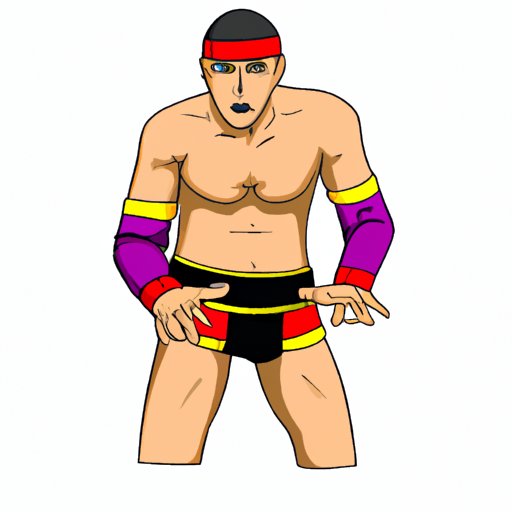Introduction
In the world of professional wrestling, there are two types of wrestlers – the faces (the good guys) and the heels (the bad guys). While faces are often cheered on by the audience, heels are considered the villains of the wrestling world. They cheat, play dirty, and do whatever it takes to win a match. But what is a wrestling heel, and why are they important in the wrestling industry? In this article, we’ll delve deep into the art of villainy and explore the role of the wrestling heel.
Becoming a Wrestling Heel: An Inside Look at the Art of Villainy
A wrestling heel is a wrestler who is portrayed as a villain in the storyline. They are often arrogant, manipulative, and sadistic, and they use any means necessary to win their matches. Becoming a successful wrestling heel requires a combination of charisma, acting ability, and in-ring skills.
Creating a wrestling character involves developing a unique persona that will resonate with the audience. For a wrestling heel, this means crafting a villainous persona that will evoke a negative reaction from the crowd. This might involve using a particular gimmick or catchphrase, wearing dark colors or flashy costumes, or incorporating elements of their real-life personality into their character.
Examples of successful wrestling heels in history include “Rowdy” Roddy Piper, “The Million Dollar Man” Ted DiBiase, and Ric Flair. These wrestlers were able to establish themselves as villains in the eyes of the audience and use their personas to create memorable moments in wrestling history.
Unpopular, but Essential: The Role of the Wrestling Heel
While wrestling heels may not be the most popular characters in a storyline, they play an essential role in the wrestling industry. A good wrestling heel can add depth and drama to a match, creating a storyline that is more compelling for the audience.
The dynamics between a wrestling heel and their opponent are essential. A wrestling heel will often use underhanded tactics to gain an advantage, which creates an emotional response from the audience. This response can range from anger to frustration to a desire to see the wrestling heel get their comeuppance.
By evoking these emotions in the audience, a wrestling heel can keep them engaged and invested in the storyline. The audience wants to see a wrestling heel get what’s coming to them, whether that means losing a match or being humiliated in some other way.
Breaking Down the Techniques of a Wrestling Heel Wrestler
Physical and verbal tactics are often used by wrestling heels to gain an advantage in matches. These tactics can include things like eye pokes, low blows, and using foreign objects in the ring. Verbal attacks, such as insults and taunts, are also commonly used to weaken an opponent’s resolve and confidence.
Timing and pacing are also crucial when executing heel techniques. A well-timed attack can catch an opponent off-guard and create a moment of drama for the audience. Similarly, pacing the match so that the heel is in control for a significant amount of time adds tension and keeps the audience engaged.
Turned to the Dark Side: The Journey of Wrestlers Who Become Heels
Wrestlers may choose to become a heel for a variety of reasons. Some wrestlers may feel that they have hit a creative wall and need to reinvent themselves. Others may want to try something new after spending a significant amount of time as a face.
The experience of turning from a face to a heel can be challenging, both professionally and personally. Being cast as a villain can be a significant departure from the previous character that a wrestler played, and it can take time and effort to get into the mindset of a heel. On the other hand, playing a heel can be liberating, allowing wrestlers to explore new facets of their personality and character.
How Wrestlers Use Psychology to Become Successful Heels
Psychology plays a significant role in wrestling. The audience is invested in the stories that are told in the ring, and they are looking for emotional connections with the wrestlers. As a wrestling heel, it’s essential to understand how to manipulate the audience’s emotions and reactions.
Using body language, facial expressions, and tone of voice can help convey attitude and personality. The wrestling heel’s goal is to make the audience hate them, and these non-verbal cues can help create the desired effect.
The Evolution of Wrestling Villains: From Caricatures to Complex Characters
The history of wrestling heels has evolved over time. Early wrestling villains often played up their physical differences from other wrestlers, creating exaggerated characters that were little more than caricatures. In recent years, however, wrestling heels have become more complex and multi-dimensional.
Current wrestling heels, such as Bray Wyatt and “The Fiend,” are incredibly nuanced characters that embody the darker side of human nature. These characters are terrifying, yet they are also relatable, which makes them all the more compelling to watch.
Conclusion
The art of being a wrestling heel is a complex and challenging one. It requires a combination of in-ring skill, charisma, and acting ability to create a compelling character that the audience will love to hate. But the role of the wrestling heel is an essential one, adding depth and drama to wrestling storylines. By using a combination of physical and verbal tactics and understanding the psychology of the audience, wrestling heels can become some of the most memorable characters in wrestling history.
